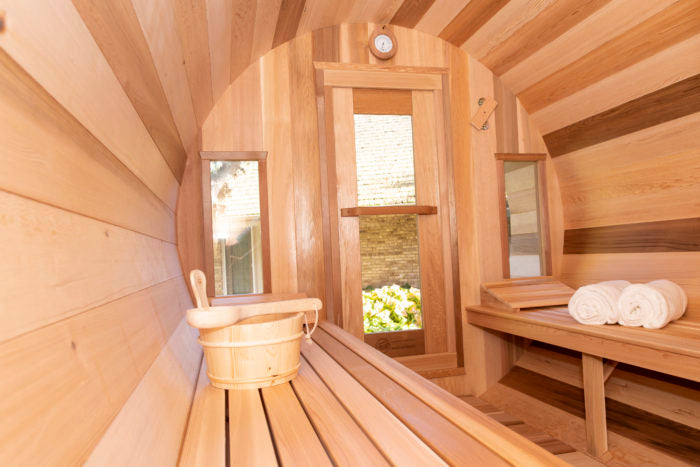7 Easy Facts About Traditional Sauna Explained
7 Easy Facts About Traditional Sauna Explained
Blog Article
About Traditional Sauna
Table of Contents10 Easy Facts About Traditional Sauna DescribedThe Definitive Guide for Traditional SaunaThe Basic Principles Of Traditional Sauna Indicators on Traditional Sauna You Need To KnowThe Definitive Guide for Traditional Sauna
Most of the weight lost in a sauna is water loss and is re-gained upon rehydrating. Without an uncertainty sauna can be a crucial part of a healthy and balanced weight loss program. To look at the differences between traditional and IR saunas, I will certainly divide these right into proven, theoretical, and made distinctions.Hence, the best point in the saunawhich goes to the ceiling straight over the sauna heateris typically in between 185 and 190 F. Claims that a traditional sauna exceeds 200 F is merely not real and not relevant for electrical saunas offered in the US. The temperature level for a far-infrared sauna is generally established between 120 and 140 F; nevertheless, unlike the standard sauna, the goal in and IR area is not to achieve a high temperature.

When a conventional sauna has been effectively heated up, the sauna wall surfaces are warm, the air temperature has actually accomplished set temperature level and the rocks are incredibly heated. As a fascinating side note, the warmed walls and the rocks are producing far-infrared warmth, integrated with the warmed air, to create an "wrapping up heat".
The Traditional Sauna PDFs
When the heat is accomplished, the elements cycle on and off to maintain the heat. Most typical sauna individuals enjoy putting water over the rocks to develop heavy steam to increase sauna moisture degrees. The advantages of putting water over the rocks consist of: making the space much more comfy, dampening the nasal passages, and allowing the use of aromatherapy by blending important oils with the water.

When the energy gets in the body, it creates the body temperature level Our site to enhance and eventually leads to sweating. In an infrared sauna it is necessary for the emitters/heaters to stay on nearly constantly. Since there is no mass of rocks to maintain heat, the sauna will cool down if the emitters closed off.
Traditional Sauna - Truths
As discussed over, the sauna bather in an infrared area wants to place himself before operating emitters to obtain maximum benefit from the warmth. The heating time for both areas can be extremely different, relying on exactly how the rooms are made use of. For a conventional sauna, a bather ought to permit 30-40 mins for the room to achieve a why not try these out preferred temperature and to properly pre-heat the rocks.

A well built sauna will usually accomplish a temperature level of 150-160 F in about 30-40 mins. For hotter temperature levels, the space might need to warmth for a longer duration.
To some, 15 minutes was "squandered" while the infrared power heated up the wood panels instead of heating up a body, while others find a pre-heated area to be try this out a lot more comfy and think an elevated beginning temperature is essential to begin perspiring. The length of suggested use for each area is roughly the very same (10-15 minutes per session); however, because of the reduced air temperature levels and the capacity to feel the results of infrared heat much faster than a conventional sauna, it is not uncommon for a person to spend a total of 20-30 minutes in an infrared sauna.
The 2-Minute Rule for Traditional Sauna

The typical expense per kWH of electricity in the U.S. is about $0.11, so a 4.5 kW heating system will certainly set you back around $.50 to compete one hour, if the heating system runs continually for one hour. Commonly a sauna heating system will certainly run for 75% of the first hour and 50% of subsequent hours on because the components cycle once the established temperature level is accomplished.
A two person far-infrared space is usually physically smaller than a typical sauna, usually about 4' x 4' or smaller. The IR furnace is normally 1.5-1.7 kW utilizing a 120 volt 15 amp plug-in solution. Because the space can be made use of faster than a sauna space, we will certainly assume the space is utilized for to of an hour consisting of warm up time.
Finally, there is a rarely talked about distinction in the social experience in between the 2 rooms. While our culture has lost several of the social advantage of the traditional sauna experience, it can be really socially fulfilling (Traditional Sauna). From family members time in the sauna, to heart-felt conversations with significant others, to sauna partiesthe standard sauna experience can cause intimate mingling
8 Simple Techniques For Traditional Sauna
Many greater end infrared areas include colored light therapy, audio systems and full-glass fronts.
Report this page